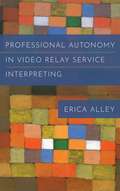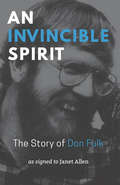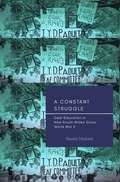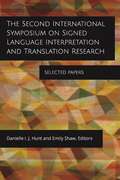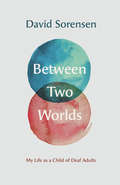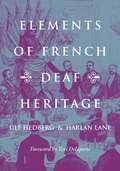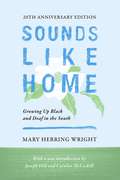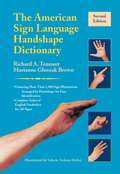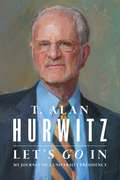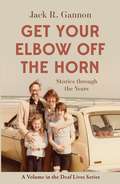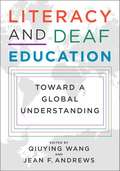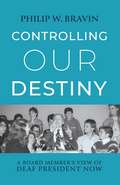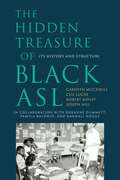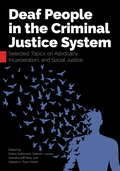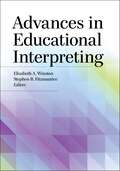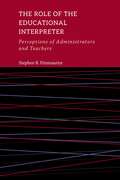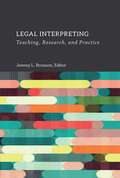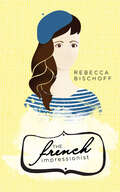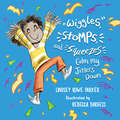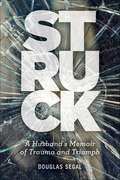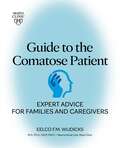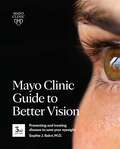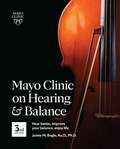- Table View
- List View
Professional Autonomy in Video Relay Service Interpreting (Gallaudet Studies In Interpret #17)
by Erica AlleyVideo relay service (VRS) is a federally funded service that provides telecommunications access for deaf people. It is also a for-profit industry with guidelines that may limit the autonomy of the sign language interpreters who work in VRS settings. In this volume, Erica Alley examines how VRS interpreters, or “Communication Assistants,” exercise professional autonomy despite the constraints that arise from rules and regulations established by federal agencies and corporate entities. Through interviews with VRS interpreters, Alley reveals the balance they must achieve in providing effective customer service while meeting the quantitative measures of success imposed by their employer in a highly structured call center environment. Alley considers the question of how VRS fits into the professional field of interpreting, and discovers that—regardless of the profit-focused mentality of VRS providers—interpreters make decisions with the goal of creating quality customer service experiences for deaf consumers, even if it means “breaking the rules.” Her findings shed light on the decision-making process of interpreters and how their actions are governed by principles of self-care, care for colleagues, and concern for the quality of services provided. Professional Autonomy in Video Relay Service Interpreting is essential reading in interpreter education courses and interpreter training programs.
An Invincible Spirit: The Story of Don Fulk
by Janet Allen“Don taught us how to be a real independent living center. Nothing was easy; every issue that came up on the road to Don’s independence was a challenge and a struggle, but the experience pushed us and we learned from it. We were not going to let Don down; all of us were committed to Don’s freedom and independence.” —Kathleen Kleinman, Executive Director, TRPIL (Transitional Paths to Independent Living) Profoundly deafened as an infant, Don Fulk didn’t learn his name or go to school until the age of ten. When he was eighteen years old and a budding superstar on his football and basketball teams, he broke his neck in a swimming accident, and became paralyzed. After his injury, he was confined to a bed in his parents’ home for eight years, unable to move and barely able to communicate. After his family could no longer care for him, he spent nine years in a nursing home where he suffered from abuse and neglect. Yet through a life marred by isolation and frustration, Fulk endured with strength, humor, and grace. He never gave up pursuing his dreams for independence and self-worth, and improving the lives of others. He fought a system that was unfair and discriminatory, and helped pave the way for people with disabilities to live independently. Don Fulk signed his story to author Janet Allen, describing his difficult home life, the incredible friends who changed his life, and his dramatic escape from an abusive nursing home. An Invincible Spirit is a story of hope, empowerment, and the battles people with disabilities have fought—and continue to fight—to improve the quality of their lives.
An Invincible Spirit: The Story of Don Fulk
by Janet Allen“Don taught us how to be a real independent living center. Nothing was easy; every issue that came up on the road to Don’s independence was a challenge and a struggle, but the experience pushed us and we learned from it. We were not going to let Don down; all of us were committed to Don’s freedom and independence.” —Kathleen Kleinman, Executive Director, TRPIL (Transitional Paths to Independent Living) Profoundly deafened as an infant, Don Fulk didn’t learn his name or go to school until the age of ten. When he was eighteen years old and a budding superstar on his football and basketball teams, he broke his neck in a swimming accident, and became paralyzed. After his injury, he was confined to a bed in his parents’ home for eight years, unable to move and barely able to communicate. After his family could no longer care for him, he spent nine years in a nursing home where he suffered from abuse and neglect. Yet through a life marred by isolation and frustration, Fulk endured with strength, humor, and grace. He never gave up pursuing his dreams for independence and self-worth, and improving the lives of others. He fought a system that was unfair and discriminatory, and helped pave the way for people with disabilities to live independently. Don Fulk signed his story to author Janet Allen, describing his difficult home life, the incredible friends who changed his life, and his dramatic escape from an abusive nursing home. An Invincible Spirit is a story of hope, empowerment, and the battles people with disabilities have fought—and continue to fight—to improve the quality of their lives.
A Constant Struggle: Deaf Education in New South Wales Since World War II
by Naomi MaloneDeaf education in New South Wales has made tremendous progress since the end of World War II, yet issues remain for students from their early years of education through secondary high school. Naomi Malone traces the roots of these issues and argues that they persist due to the historical fragmentation within deaf education regarding oralism (teaching via spoken language) and manualism (teaching via sign language). She considers the early prevalence of oralism in schools for deaf students, the integration of deaf students into mainstream classrooms, the recognition of Australian Sign Language as a language, and the growing awareness of the diversity of deaf students. Malone’s historical assessments are augmented by interviews with former students and contextualized with explanations of concurrent political and social events. She posits that deaf people must be consulted about their educational experiences and that they must form a united social movement to better advocate for improved deaf education, regardless of communication approach.
The Second International Symposium on Signed Language Interpretation and Translation Research: Selected Papers (Gallaudet Studies In Interpret #18)
by Danielle I. J. Hunt Emily ShawThe Second International Symposium on Signed Language Interpretation and Translation Research was a rare opportunity for hearing and Deaf students, researchers, educators, and practitioners to come together and learn about current research in Interpretation and Translation Studies. These selected papers are comprised of research conducted in places such as Australia, Flanders, France, and Ghana, creating a volume that is international in scope. Editors Danielle I. J. Hunt and Emily Shaw have collected papers that represent the advances in the depth and diversity of knowledge in the field of signed language interpretation and translation research. Chapter topics include the use of haptic signals when interpreting for Deafblind people, the role of French Deaf translators during the 2015 Paris terror attacks, and Deaf employees’ perspectives on interpreting in the workplace. Signed chapter summaries will be available on the Gallaudet University Press YouTube channel upon publication.
Between Two Worlds: My Life as a Child of Deaf Adults (Gallaudet Studies In Interpret Ser. #17)
by David SorensenIn his memoir, David Sorensen explores his identity as a coda, or a child of Deaf adults. He describes his experiences with the roles often placed on codas at a young age, such as interpreter, confidant, and decision-maker. His story reveals a person seeking acceptance and belonging while straddling the Deaf and hearing worlds, and shows how he found reconciliation within himself and with both worlds. Sorensen relays the dynamics of his family life; he had a strained relationship with his father, who was an active leader and role model in the Deaf community and the Mormon Church, yet struggled to bond with his own son. Sorensen rebelled as a youth and left home as a teenager, completely detaching from the Deaf community. After struggling to establish himself as an independent adult, he discovered that he wanted to return to the Deaf world and use his ASL fluency and cultural understanding as a mental health therapist and community advocate. Now he considers himself an ambassador between the Deaf and hearing worlds, as well as between the older and younger generations of Deaf people. Between Two Worlds: My Life as a Child of Deaf Adults shares the unique experiences of a coda and passes on the rich cultural past shared by the American Deaf community.
Between Two Worlds: My Life as a Child of Deaf Adults
by David SorensenIn his memoir, David Sorensen explores his identity as a coda, or a child of Deaf adults. He describes his experiences with the roles often placed on codas at a young age, such as interpreter, confidant, and decision-maker. His story reveals a person seeking acceptance and belonging while straddling the Deaf and hearing worlds, and shows how he found reconciliation within himself and with both worlds. Sorensen relays the dynamics of his family life; he had a strained relationship with his father, who was an active leader and role model in the Deaf community and the Mormon Church, yet struggled to bond with his own son. Sorensen rebelled as a youth and left home as a teenager, completely detaching from the Deaf community. After struggling to establish himself as an independent adult, he discovered that he wanted to return to the Deaf world and use his ASL fluency and cultural understanding as a mental health therapist and community advocate. Now he considers himself an ambassador between the Deaf and hearing worlds, as well as between the older and younger generations of Deaf people. Between Two Worlds: My Life as a Child of Deaf Adults shares the unique experiences of a coda and passes on the rich cultural past shared by the American Deaf community.
Elements of French Deaf Heritage
by Ulf Hedberg Harlan LaneFrench Deaf culture is regarded as a major influence on the formation of other Deaf cultures around the world, notably American Deaf culture. In Elements of French Deaf Heritage, Ulf Hedberg and Harlan Lane document the development of Deaf culture in France by way of Deaf schools, Deaf associations, private and professional networks, publishing, and the arts. This highly visual work captures these forces from the late 18th century through the end of the 19th century, when cultural formation began to shift to cultural maintenance. Encyclopedic in scope, this examination of the evolution of Deaf ethnicity in France aims to disseminate an extensive amount of archival information, now available for the first time in the English language.
Sounds Like Home: Growing Up Black and Deaf in the South
by Mary Herring WrightOriginally published in 1999, Sounds Like Home adds an important dimension to the canon of deaf literature by presenting the perspective of an African American deaf woman who attended a segregated deaf school. Mary Herring Wright documents her life from the mid-1920s to the early 1940s, offering a rich account of her home life in rural North Carolina and her education at the North Carolina School for the Deaf and Blind, which had a separate campus for African American students. This 20th anniversary edition of Wright’s story includes a new introduction by scholars Joseph Hill and Carolyn McCaskill, who note that the historical documents and photographs of segregated Black deaf schools have mostly been lost. Sounds Like Home serves “as a permanent witness to the lives of Black Deaf people.”
The American Sign Language Handshape Dictionary
by Richard A. Tennant Marianne Gluszak BrownThis unique reference can help users locate a sign whose meaning they have forgotten, or help them find the meaning of a new sign they have just seen for the first time. It organizes more than 1,900 ASL signs by 40 basic handshapes and includes detailed descriptions on how to form these signs to represent the different English words that they might mean. Users can begin to track down a sign by determining whether it is formed with one hand or two. Further distinctions of handshape, palm orientation, location, movement, and nonmanual signals help them pinpoint their search while also refining their grasp of ASL syntax and grammar. A complete English word index provides the option of referring to an alphabetical listing of English terms to locate an equivalent sign or choice of signs. This dictionary features: More than 1,900 sign illustrations, organized by handshape Complete index of English vocabulary for all signs An introduction to Deaf culture and ASL structure The American Sign Language Handshape Dictionary is a one-of-a-kind resource for learning ASL and enhancing communication skills in both ASL and English.
Let’s Go In: My Journey to a University Presidency
by T. Alan HurwitzAlan Hurwitz ascended the ranks of academia to become the president of not one, but two, universities—National Technical Institute for the Deaf at Rochester Institute of Technology and Gallaudet University. In Let’s Go In: My Journey to a University Presidency, Hurwitz discusses the unique challenges he encountered as a Deaf person, and the events, people, and experiences that shaped his personal and professional life. He demonstrates the importance of building a strong foundation for progressive leadership roles in higher education, and provides insights into the decision-making and outreach required of a university president, covering topics such as community collaboration, budget management, and networking with public policy leaders. He also stresses that assessing students’ needs should be a top priority. As he reflects on a life committed to service in higher education, Hurwitz offers up important lessons on the issues, challenges, and opportunities faced by deaf and hard of hearing people, and in doing so, inspires future generations of deaf people to aim for their highest goals.
Get Your Elbow Off the Horn: Stories through the Years (Gallaudet New Deaf Lives #10)
by Jack R. GannonGet Your Elbow Off the Horn is a collection of interactions and observations written by Jack R. Gannon, a lifelong advocate for the Deaf community. Warm and amusing, Gannon’s stories begin with his rural childhood in the Ozarks and continue through his experiences as a student, educator, coach, husband, parent, and community leader. These vignettes reveal a down-to-earth family man who believed in making a difference one person at a time. Many of his recollections are brief sketches that reveal much about being Deaf—and about being human. From reflecting on the difficult choices parents must make for their children, to recounting awkward communication exchanges, Gannon marries good humor with a poignant advocacy for sign language rights. His stories preserve and share Deaf American life and culture as he experienced it.
Literacy and Deaf Education: Toward a Global Understanding
by Qiuying Wang Jean AndrewsInternational perspectives about literacy and deaf students is an uncharted intellectual landscape. Much of the literacy research in deaf education is conducted in English-speaking countries—primarily the United States—but 90% of deaf children live outside the U.S. and learn various signed and spoken languages, as well as diverse writing systems. Many of these children face significant educational challenges. In order to improve the literacy outcomes of deaf students around the world, it is imperative to study how children are using their local signed and spoken languages along with Deaf culture to learn to read and write. This volume fills a void in the field by providing a global view of recent theoretical and applied research on literacy education for deaf learners. Literacy and Deaf Education: Toward a Global Understanding is organized by region and country, with the first part discussing writing systems that use alphabetic scripts, and the second part focusing on countries that use non-alphabetic scripts. Some examples of the wide spectrum of topics covered include communication methodologies, curriculum, bilingual education, reading interventions, script diversity, and sociocultural development, including Deaf cultural developments. The contributors provide the results from literacy projects in fifteen countries and regions. This volume aims to widen the knowledge base, familiarize others in the field with these initiatives, and improve global understandings and outcomes of literacy teaching and learning in deaf education from birth to high school. Signed chapter summaries are available on the Gallaudet University Press YouTube channel.
Controlling Our Destiny: A Board Member’s View of Deaf President Now
by Philip W. BravinIn March 1988, students at Gallaudet University led a successful protest to demand the selection of the university’s first deaf president. The Deaf President Now (DPN) movement was a watershed event in American deaf history; it achieved self-governance for the deaf community and placed Gallaudet in the center of a national media spotlight. Controlling Our Destiny is Philip Bravin’s personal perspective of these momentous events. A lifelong member of the deaf community and proud Gallaudet alumnus, Bravin was a member of the Gallaudet University Board of Trustees and the chair of the presidential search committee during DPN. Although the deaf community had been strongly advocating for a deaf president to lead the university, the board (which had a hearing majority) selected the lone hearing candidate. Bravin recounts the discussions and decision-making that happened behind the scenes leading up to and following the ill-fated announcement. He reflects on the integrity of the process and the internal conflict he experienced as a deaf person who supported a deaf president yet felt compelled to abide by his duties as a board member. After the protests, his leadership was recognized when he was selected as the first deaf chair of the board. Photographs and documents add depth to Bravin’s account, many of which will be seen by the public for the first time. I. King Jordan, the first deaf president of Gallaudet, provides a foreword in which he shares his own unique insight into these events. Controlling Our Destiny captures the energy and the urgency of DPN. Readers will understand the complexities of the presidential search process and the cultural and historical contexts that triggered the protest. Bravin’s memoir contemplates power, access, community, and the enduring legacy of a movement that inspired deaf people around the world.
The Hidden Treasure of Black ASL: Its History and Structure
by Carolyn McCaskill Ceil Lucas Robert Bayley Joseph Christopher HillBlack ASL has long been recognized as a distinct variety of American Sign Language based on abundant anecdotal evidence. The Hidden Treasure of Black ASL, originally published in 2011, presents the first sociohistorical and linguistic study of this language variety. Based on the findings of the Black ASL Project, which undertook this unprecedented research, Hidden Treasure documents the stories and language of the African American Deaf community. With links to online supplemental video content that includes interviews with Black ASL users (formerly on DVD), this volume is a groundbreaking scholarly contribution and a powerful affirmation for Black Deaf people. This paperback edition includes an updated foreword by Glenn B. Anderson, a new preface that reflects on the impact of this research, and an expanded list of references and resources on Black ASL. The supplemental video content is available online at the Gallaudet University Press YouTube Channel. Under Playlists, click “The Hidden Treasure of Black ASL: Companion Video to the Book.” As featured in the film Signing Black in America: The Story of Black ASL, produced by The Language and Life Project at North Carolina State University (Dr. Walt Wolfram, Executive Producer). Look for it on PBS.
Deaf People in the Criminal Justice System: Selected Topics on Advocacy, Incarceration, and Social Justice
by Debra Guthmann Gabriel I. Lomas Damara Goff Paris Gabriel A. “Tony” MartinThe legal system is complex, and without appropriate access, many injustices can occur. Deaf people in the criminal justice system are routinely denied sign language interpreters, videophone access, and other accommodations at each stage of the legal process. The marginalization of deaf people in the criminal justice system is further exacerbated by the lack of advocates who are qualified to work with this population. Deaf People in the Criminal Justice System: Selected Topics on Advocacy, Incarceration, and Social Justice is the first book to illuminate the challenges faced by deaf people when they are arrested, incarcerated, or navigating the court system. This volume brings interdisciplinary contributors together to shed light on both the problems and solutions for deaf people in these circumstances. The contributors address issues such as accessibility needs; gaps regarding data collection and the need for more research; additional training for attorneys, court personnel, and prison staff; the need for more qualified sign language interpreters, including Certified Deaf Interpreters who provide services in court, prison, and juvenile facilities; substance use disorders; the school to prison nexus; and the need for advocacy. Students in training programs, researchers, attorneys, mental health professionals, sign language interpreters, family members, and advocates will be empowered by this much-needed resource to improve the experiences and outcomes for deaf people in the criminal justice system.
Advances in Educational Interpreting
by Elizabeth A. Winston; Stephen B. FitzmauriceIn this follow up to Educational Interpreting: How It Can Succeed, published in 2004, Elizabeth A. Winston and Stephen B. Fitzmaurice present research about the current state of educational interpreting in both K-12 and post-secondary settings. This volume brings together experts in the field, including Deaf and hearing educational interpreters, interpreter researchers, interpreter educators, and Deaf consumers of educational interpreting services. The contributors explore impacts and potential outcomes for students placed in interpreted education settings, and address such topics as interpreter skills, cultural needs, and emergent signers. Winston and Fitzmaurice argue massive systemic paradigm shifts in interpreted educations are as needed now as they were when the first volume was published, and that these changes require the collaborative efforts of everyone on the educational team, including: administrators, general education teachers, teachers of the deaf, interpreters, and counselors. The contributors to this volume address research-based challenges and make recommendations for how interpreting practitioners, and all members of the educational team, can enact meaningful changes in their work towards becoming part of a more comprehensive solution to deaf education.
The Role of the Educational Interpreter: Perceptions of Administrators and Teachers (The Interpreter Education Series #11)
by Stephen B. FitzmauriceWhile educational interpreting has been studied for decades, the research has historically focused on the tasks educational interpreters are engaged in during their work day. In The Role of the Educational Interpreter, Stephen B. Fitzmaurice takes a new approach using role theory to examine how administrators and teachers perceive the role and work of educational (K–12) interpreters. Through a series of qualitative interviews and quantitative questionnaires with district administrators, school administrators, general education teachers, and teachers of the deaf, Fitzmaurice documents their perceptions of educational interpreters. Findings from the data reveal the perceptions of administrators and teachers set the stage for role ambiguity, role conflicts, and subsequent role overload for educational interpreters. Fitzmaurice elaborates on the implications of the research, and also provides concrete recommendations for researchers and practitioners, including an emphasis on the importance of involving the Deaf community in this work. This volume aims to offer clarity on the role of the educational interpreter, and dispel the confusion and conflicts created by divergent perspectives. A shared understanding of the role of the educational interpreter will allow administrators, teachers, and interpreters to work collaboratively to improve educational outcomes for deaf students.
Legal Interpreting: Teaching, Research, and Practice (The Interpreter Education Series #12)
by Jeremy L. BrunsonLinguistic minorities are often severely disadvantaged in legal events, with consequences that could impact one’s very liberty. Training for interpreters to provide full access in legal settings is paramount. In this volume, Jeremy L. Brunson has gathered deaf and hearing scholars and practitioners from both signed and spoken language interpreting communities in the United States, Canada, and the United Kingdom. Their contributions include research-driven, experience-driven, and theoretical discussions on how to teach and assess legal interpreting. The topics covered include teaming in a courtroom, introducing students to legal interpreting, being an expert witness, discourses used by deaf lawyers, designing assessment tools for legal settings, and working with deaf jurors. In addition, this volume interrogates the various ways power, privilege, and oppression appear in legal interpreting. Each chapter features discussion questions and prompts that interpreter educators can use in the classroom. While intended as a foundational text for use in courses, this body of work also provides insight into the current state of the legal interpreting field and will be a valuable resource for scholars, practitioners, and consumers.
The French Impressionist
by Rebecca BischoffRosemary is fifteen and gloriously free, on her own for the very first time. Part of an exchange program for aspiring artists, she arrives in southern France with one goal: she doesn’t plan to leave, ever. She wants a new life and a new identity. But her situation, crafted from lies big and small, is precarious. As Rosemary struggles to hide her lack of artistic talent and obvious communication disorder from her new family, she must ultimately choose whether or not she’ll tell the biggest lie of all, even if it means destroying the life of someone she cares about.
Wiggles, Stomps, and Squeezes Calm My Jitters Down
by Lindsey Rowe ParkerThis is a story about sensory differences and how some children experience their world, told from a child's perspective.The vibration in her feet when she runs, the tap-tap-tap of her fork on the table at mealtime, the trickle of cool water running over her hands---these are the things that calm her jitters down. This book is for anyone who has ever felt the need for a wiggle,s tomp, or squeeze!Wiggles, Stomps, and Squeezes playfully validates the unique sensory experiences of children, written from their own perspective. I'm excited for every kid that will see themselves in this beautiful book!" - Mark Loewen, Author of What Does a Princess Really Look Like?"I have worked in special education for 12 years and have not ccome across a book that explains these jittery feelings until now. This book will capture the hearts of families and children with unique needs as well as educate those unfamiliar with sensory differences." - Bridget Martinez, Special Education Teacher "I often find myself trying to explain to parents why their child needs wiggles, stomps, and squeezes to get through their day while experiencing sensory input in ways that are different and often more intense. This is the first book I have come across that provides a very real glimpse into the lived experience of a child with sensory differences. What a wonderful book that so many families can benefit from!? - Caitlyn Berry, Occupational Therapist
Struck: A Husband's Memoir Of Trauma And Triumph
by Douglas SegalOne of life's biggest clichés becomes a horrific reality when Douglas Segal's wife and young daughter are hit head-on by a Los Angeles city bus. Miraculously, his daughter was unharmed, but his wife faced a series of life-threatening injuries, including the same one that famously left Christopher Reeve paralyzed. Following the accident, Segal began sending regular email updates to their circle of friends and family--a list that continued to grow as others heard of the event and were moved by the many emotional and spiritual issues it raised. Segal's compelling memoir is an intimate and honest chronicle built around these email updates, and is a profound example of how people show up for one another in times of crisis. Alternatingly harrowing, humorous, heartbreaking, and hopeful, this is an uplifting tribute to love, determination, and how the compassion of community holds the power to heal, serving as an inspiring testament to the resilience of the human spirit when faced with pain and adversity.
Guide to the Comatose Patient: Expert advice for families and caregivers
by Dr. Eelco WijdicksCaring for a loved one in a coma is a distressing time, full of many questions, and often, not as many answers. Guide to a Comatose Patient is a first-of-its-kind book that steps into the shoes of the neurologist, to show the perspective of the staff caring for their loved ones — what worries us, how we think and intervene, what we can and cannot predict, and what we know as a certainty.In our hospital ICUs, there are more than a dozen comatose patients at any given point of time. Causes of coma can range from drug-induced coma—in which medications are used to calm the patient and allow the ventilator to work properly—to coma due to intoxication and coma related to a brain injury. No matter the reason, it can be a distressing time for loved ones. Guide to a Comatose Patient is a helpful guide for any family member or loved one confronted with coma. Author Eelco F. M. Wijdicks, M.D., Ph.D., a leading neurologist and attending neurointensivist at Mayo Clinic, begins each chapter by sharing helpful anecdotes from a career spanning four decades, before diving into the answers to commonly asked questions, such as: · What are the causes of coma? · When will the patient wake up and recover? · When is no recovery expected? · When should we consider organ donation? · What are the rates of survival? While there are many books on families&’ experiences with acute traumatic brain injury and coma, Dr. Wijdicks offers an unusually candid conversation that allows a peek inside the minds of the doctors caring for your loved one. Having had many experiences talking to families having to make difficult decisions at a very difficult time, Dr. Wijdicks&’s message is hopeful while remaining grounded in reality—a reality in which facts must dictate actions. Guide to a Comatose Patient provides important information so that families better understand treatment options, but most importantly, the book offers an open dialogue and optimal transparency to help provide hope and healing through times of grief.
Mayo Clinic Guide to Better Vision (3rd Edition): Preventing and treating disease to save your eyesight
by Dr. Sophie J. BakriHaving good eyesight is essential for almost every activity we do, but an estimated 93 million adults in the United States are at high risk for serious vision loss. Mayo Clinic Guide to Better Vision is a comprehensive guide to understanding common vision problems, preventing age-related eye disorders, and keeping your eyes healthy at every stage of life.As we age, our eyes become more susceptible to common conditions like age-related macular degeneration, glaucoma, diabetic retinopathy and cataracts. Even younger adults can suffer from painful eye conditions like dry eyes, infected tear ducts, styes, floaters, pink eye, and eye strain. More than 170 million Americans wear eyeglasses or contact lenses to correct vision problems, and those number is likely to increase. Fortunately, many of these conditions are preventable, treatable, and even reversible. In Mayo Clinic Guide to Better Vision, Dr. Sophie Bakri, M.D. walks readers through the diagnoses and treatment options associated with these common eye issues, as well as preventive measures for protecting your eyes from eye diseases, retinal disorders, and permanent vision loss. She also shares the best techniques for correcting common vision problems, and provides tools for those currently living with low vision. Presented through clear, conversational explanations paired with detailed illustrations, photographs, and tables, this book is a practical resource for making the most of your vision by keeping your eyes healthy and your eyesight sharp at any age.
Mayo Clinic on Hearing and Balance, 3rd ed: Hear Better, Improve Your Balance, Enjoy Life
by Jamie BogleIf you struggle with hearing loss and balance issues, you&’re not alone; nearly 500 million people around the world also suffer. In Mayo Clinic on Hearing and Balance, leading audiologist Jamie M. Bogle helps readers understand the causes of hearing loss and balance issues, how these conditions can be prevented, and how those afflicted with these issues can improve their quality of life.Hearing impairment can be a debilitating condition. From tinnitus and benign paroxysmal positional vertigo to chronic migraines and ear infections, there are a host of underlying causes that can impact your ability to hear well. And hearing loss often goes hand-in-hand with feelings of vertigo. Problems with balance and chronic dizziness can affect every aspect of daily life and put you at risk of injury. In Mayo Clinic on Better Hearing and Balance, you'll get the answers to many common questions about hearing and balance, like how hearing and balance are tested, ways to protect your hearing health, what you can do to improve your balance, how underlying causes of hearing loss are treated, and how to select hearing aids and cochlear implants. You will also find helpful tips and tools for improving your quality of life while living with hearing and balance issues, as well as real-life solutions for recovering from some of the more immobilizing symptoms of the condition. With Mayo Clinic on Better Hearing and Balance, you can take back control of your life and move past your common hearing and balance issues.
